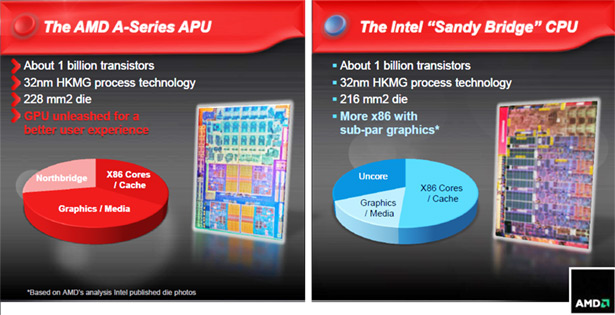AMD A8-3850 Llano APU and Lynx Platform Preview
A couple of weeks back, we took a look at AMD's Llano mobile platform, with a mainstream notebook from Compal, and we came away impressed. If you're unfamiliar with Llano, be sure to check out our launch coverage (available here). But to quickly recap, Llano is the codename for AMD's latest Fusion-based product, that combines a CPU and GPU on a single piece of silicon. In the mobile space, Llano offers a capable quad-core CPU, with excellent DX11-class integrated graphics, in a very low power-envelope. Those things translate into good performance and solid battery life in a notebook, two highly desirable traits of mobile system.
AMD is now ready with Llano-based products for the desktop. On the desktop, Llano offers similar things. In fact, the underlying technology is identical. But the desktop landscape is very different from the mobile space. Desktops aren't constrained by the limited form-factors and thermal requirements of mobile systems, and as such, Llano has to compete with a much broader range of options and architectures.

AMD Llano Die Shot...
AMD thinks they have struck the right balance between CPU and GPU performance though, and at some very budget-friendly price points. Ultimately, consumers will decide if AMD is on target. In the meantime, we've got the first AMD Llano-based desktop APU, the A8-3850, in the lab, complete with a quartet of A75-chipset based motherboards. Pairing an A-Series APU and A-Series chipset results in what AMD is calling their "Lynx" platform. Cool codenames aside, there's lots of tech to discuss here, so take a gander at the features and specifications below and join as as we find out if Llano is as desirable on the desktop as it is in a notebook...
|
| Tech / Package | 32nm / FM1 905-pin lidded μPGA, 40x40 mm, 1.27 mm pitch |
| TDP Configurations | 65W and 100W configurations |
| Processor Core | “Stars” 32nm HKMG process core (up to 4 cores), 128 KB L1 Cache(64 KB Instruction, 64 KB Data) 1 MB L2/Core, 128-bit FPUs |
| Memory | Up to DDR3 1866 |
| Graphics Core | Up to 400 Radeon Cores, DirectX 11 capable, UVD3 |
| Displays | Digital Display I/F DP0: Display Port, HDMI, DVI Digital Display I/F DP1: Display Port, HDMI, DVI |
| Graphics Features | AMD Dual Graphics Blu-ray 3D AMD Steady Video AMD Perfect Picture DisplayPort 1.1a, HDMI 1.4a |
| Power Management | Multiple low-power states 32-nm process for decreased power consumption PCIe core power gating PCIe speed power policy GPU power gating of Radeon Cores and video decode (UVD3) AMD Turbo Core technology on select models |
| AMD A75/AMD A55 FCH | |
| Tech/Package | 65nm / FC BGA, 605-Ball, 23x23mm, .8mm pitch |
| TDP Configurations | A75: 7.8W, A55: 7.6W |
| UMI | x4 Gen 2 |
| SATA | A75: 6 ports at 6 Gb/s, A55: 6 ports at 3 Gb/s |
| RAID | 0,1,10 |
| USB | A75: 4 USB 3.0 Ports, 10 USB 2.0 Ports, 2 USB 1.1 Internal Ports A55: 14 USB 2.0 Ports, 2 USB 1.1 Internal Ports |
| PCIe GPPs | 4x1 Gen2 |
| FIS Support | A75 only |
| CIR | CIR Receiver |
| Clock Gen | Integrated |
| Power Rails | SVID for VDDCR_CPU & VDDR_NB, fixed voltage for other rails |
| Software/Firmware |
|
| Software | Drivers: Windows 7, Windows Vista, Windows XP, Linux |
The specifications above give a glimpse into what makes Llano tick, but the slide pictured here tells more of the story. With Llano, AMD has taken the position that GPU performance is more important than CPU performance, when said CPU is "fast enough" for the vast majority of workloads. To illustrate, the slide above compares a Llano die with a Sandy Bridge die. Although they're of roughly similar size (228mm2 vs. 216mm2), AMD has devoted much more real estate to Llano's integrated GPU core, whereas Intel's x86 cores cover a larger area. There are far more technical details at play here, and we're simplifying the explanation, but the moral of the story is that Intel's architecture will offer better general compute / x86 performance, while AMD's will offer better graphics and multimedia performance. Which aspect of system performance is more important is up to the application workload, of course, but the diverging philosophies are interesting to say the least.








